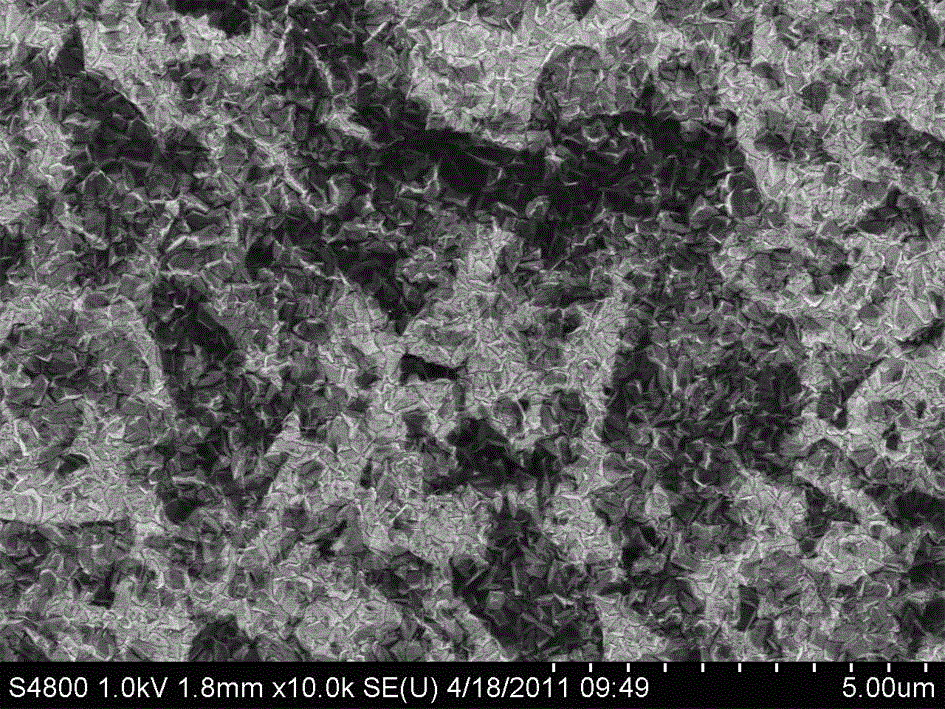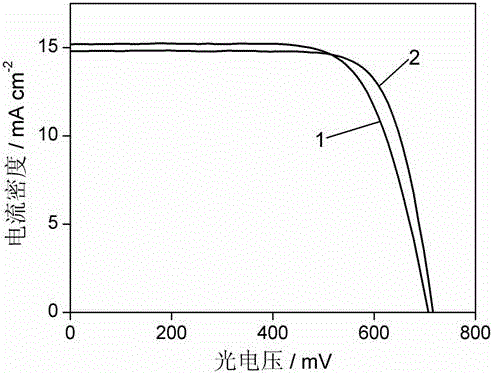Method for preparing graphene/platinum nano counter electrode material for dye sensitized solar cell
A technology for solar cells and dye sensitization, applied in the field of dye-sensitized solar cells, can solve problems such as large-scale production and application limitations, and achieve the effects of improving catalytic effect, reducing cost and simple process
- Summary
- Abstract
- Description
- Claims
- Application Information
AI Technical Summary
Problems solved by technology
Method used
Image
Examples
Embodiment 1
[0021] Soak the cleaned conductive glass in 0.5% polydiallyldimethylammonium chloride aqueous solution for 2 h, take it out, rinse it with water, dry it, and then immerse it in 0.05% graphene water suspension After taking it out, rinse it with water and dry it, then immerse it in the above polyelectrolyte for 2 hours, take it out, rinse it with water, blow it dry, and finally immerse it in a 0.05% aqueous solution of chloroplatinic acid for 2 hours. Rinse with water and dry to form a self-assembled ultra-thin film of polyelectrolyte / graphene / polyelectrolyte / chloroplatinic acid. The above ultra-thin film was sintered at 400 °C in air for 1 h to form an ultra-thin film with the structure of graphene / platinum nanoparticles.
[0022] According to the conventional method, the ultra-thin film was used as the counter electrode to assemble DSSCs, and the cell area was 0.2304 cm 2 . The current-voltage (I-V) curve of the dye-sensitized solar cell was measured under AM1.5 simulated su...
Embodiment 2
[0024] Immerse the cleaned conductive glass in a 2% polydiallyldimethylammonium chloride aqueous solution for 0.5 h, take it out, rinse it with water, dry it, and then immerse it in a 0.1% graphene ethanol suspension 0.5 h in the polyelectrolyte, rinsed with ethanol and dried after taking it out, repeated the above self-assembly process once, then immersed in the above polyelectrolyte for 0.5 h, rinsed with water after taking it out, dried, and finally immersed in 1% chlorine Put in platinum acid aqueous solution for 0.5 h, rinse with water after taking it out, and dry it to form a structure of (polyelectrolyte / graphene) 2 / Self-assembled ultrathin films of polyelectrolyte / chloroplatinic acid. The above ultra-thin film was sintered in air at 450 °C for 1 h to form a structure of (graphene) 2 / Ultrathin films of platinum nanoparticles.
[0025] According to the conventional method, the ultra-thin film was used as the counter electrode to assemble DSSCs, and the cell area...
Embodiment 3
[0027] Soak the cleaned conductive glass in 5% polydiallyldimethylammonium chloride aqueous solution for 0.2 h, take it out, rinse it with water, dry it, and then immerse it in 1% chloroplatinic acid aqueous solution After taking it out for 0.2 h, rinse it with water and dry it to form a self-assembled ultra-thin film with the structure of polyelectrolyte / chloroplatinic acid. The above ultra-thin film was sintered at 500 °C in air for 0.2 h to form an ultra-thin film with a structure of platinum nanoparticles.
[0028] According to the conventional method, the ultra-thin film was used as the counter electrode to assemble DSSCs, and the cell area was 0.2304 cm 2 . The current-voltage (I-V) curve of the dye-sensitized solar cell was measured under AM1.5 simulated sunlight, and the open circuit photovoltage ( V oc ) is 672 mV, and the short-circuit photocurrent ( J sc ) is 10.12 mA / cm 2 , fill factor ( FF ) is 0.68, and the energy conversion efficiency ( n ) is 4.62%. ...
PUM
| Property | Measurement | Unit |
|---|---|---|
| quality score | aaaaa | aaaaa |
| quality score | aaaaa | aaaaa |
Abstract
Description
Claims
Application Information
 Login to View More
Login to View More - R&D
- Intellectual Property
- Life Sciences
- Materials
- Tech Scout
- Unparalleled Data Quality
- Higher Quality Content
- 60% Fewer Hallucinations
Browse by: Latest US Patents, China's latest patents, Technical Efficacy Thesaurus, Application Domain, Technology Topic, Popular Technical Reports.
© 2025 PatSnap. All rights reserved.Legal|Privacy policy|Modern Slavery Act Transparency Statement|Sitemap|About US| Contact US: help@patsnap.com


